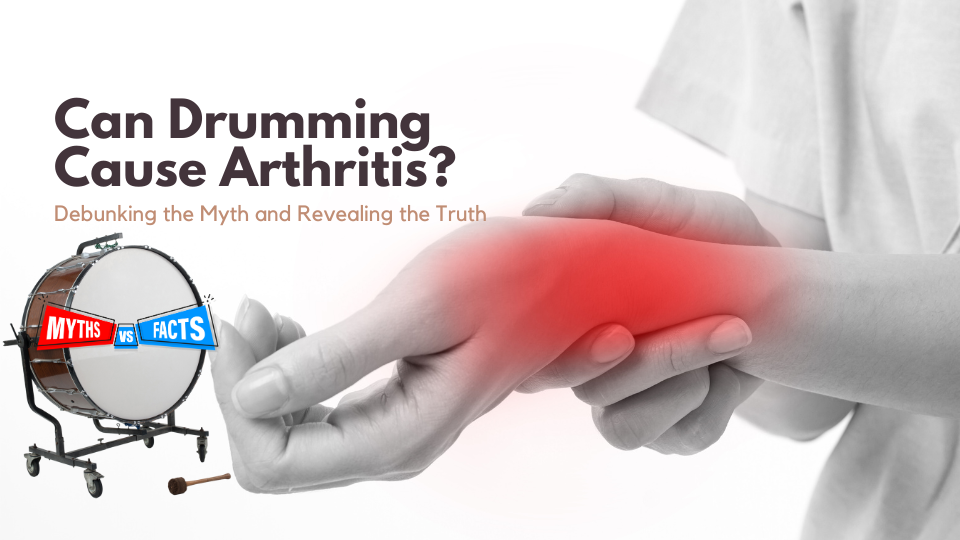This product list contains affiliate links. This means that at no extra cost to you, I may earn a commission if you use one of these links to make a purchase.
Last updated on July 9th, 2023 at 04:29 am
Can drumming cause arthritis? This is a question often pondered in relation to this popular form of musical expression, enjoyed by people of all ages and backgrounds for centuries.
Drumming involves the rhythmic striking of drums and percussion instruments to create a variety of sounds and beats. While it is generally seen as a fun and creative activity, there is some speculation about a potential link between drumming and the development of arthritis.
In this article, we will explore the question of whether drumming can cause arthritis and examine the available research on this topic.
Key Takeaways
- 🥁 Drumming involves repetitive motions, stress, and vibrations which may lead to strain and wear and tear on the joints, potentially contributing to the development or aggravation of arthritis symptoms.
- ✅ Studies have shown no direct link between drumming and the development of arthritis, some research even suggests that drumming can have positive effects on joint health, including increased flexibility and improved range of motion.
- 🧐 Individual factors such as genetic predisposition, overall joint health, and proper technique greatly influence the likelihood of developing arthritis, debunking the myth that drumming automatically leads to arthritis.
- 🏋️♀️ Proper drumming techniques, warm-up exercises, regular stretching, maintaining optimal posture, and taking breaks during extended sessions are crucial preventive measures for drummers to protect joint health.
- 🩺 For drummers already dealing with arthritis or arthritis symptoms, strategies for managing pain, reducing inflammation, and adapting drumming techniques include warming up and stretching, using proper techniques, taking breaks, using medication or topical treatments, and heat or cold therapy.
Can Drumming Cause Arthritis? Exploring the Link
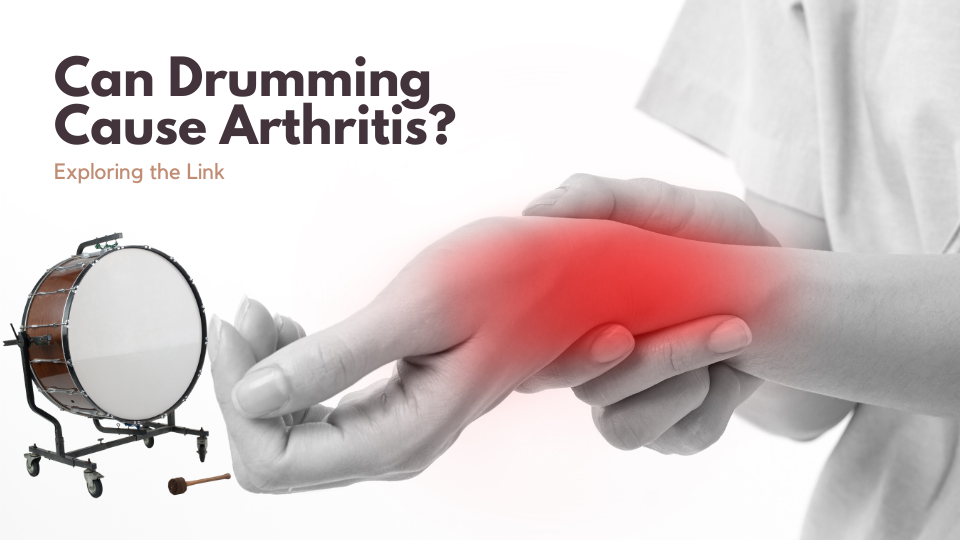
Drumming, an expressive form of music, involves a lot of repetitive hand and arm movements. This has led many to ask the question, “Can drumming cause arthritis?” As arthritis often results from repeated motions, there’s been speculation around its association with drumming.
In this discussion, we’ll delve into the potential link between drumming and arthritis, evaluating the factors that could potentially influence the emergence or exacerbation of arthritis symptoms in drummers.
Can Drumming Cause Arthritis? The Potential Link
Arthritis, a medical condition marked by joint inflammation and stiffness, often results in pain and limited mobility. While there is no concrete scientific evidence to answer definitively, “Can drumming cause arthritis?”, some research points to a potential connection.
This connection potentially links the repetitive hand and arm movements inherent in drumming to arthritis symptom development.
One theory explaining this potential link highlights the repetitive strain that drummers often endure. The continuous pounding on drums and cymbals, combined with gripping drumsticks, can exert strain on the joints and tissues surrounding them. Over time, this continuous strain might contribute to joint wear and tear, potentially causing arthritis.
Read 4 Reasons Why Bass Drum Pedal Won’t Bounce Back
Can Drumming Cause Arthritis? Factors that May Influence Arthritis Symptoms in Drummers
Several factors might contribute to the emergence or worsening of arthritis symptoms in drummers. When considering, “Can drumming cause arthritis?” one must account for the intensity and duration of drumming sessions.
Drummers engaged in vigorous, lengthy practice or performance sessions may be more likely to overuse their joints, which could lead to arthritis symptoms.
Additionally, a drummer’s technique and posture can have significant effects on joint health. An improper drumming technique, such as excessive force or incorrect hand positioning, can introduce unnecessary stress on the joints.
This could increase the risk of arthritis. Similarly, poor posture during play may make drummers more prone to joint problems.
Finally, the question, “Can drumming cause arthritis?” cannot be fully addressed without considering individual susceptibility to arthritis, which can vary among drummers.
Factors like genetics, age, and pre-existing joint conditions can influence the chances of developing arthritis symptoms. Drummers with a family history of arthritis or existing joint issues may be at a higher risk.
Understanding if Drumming Can Cause Arthritis: The Potential Effects
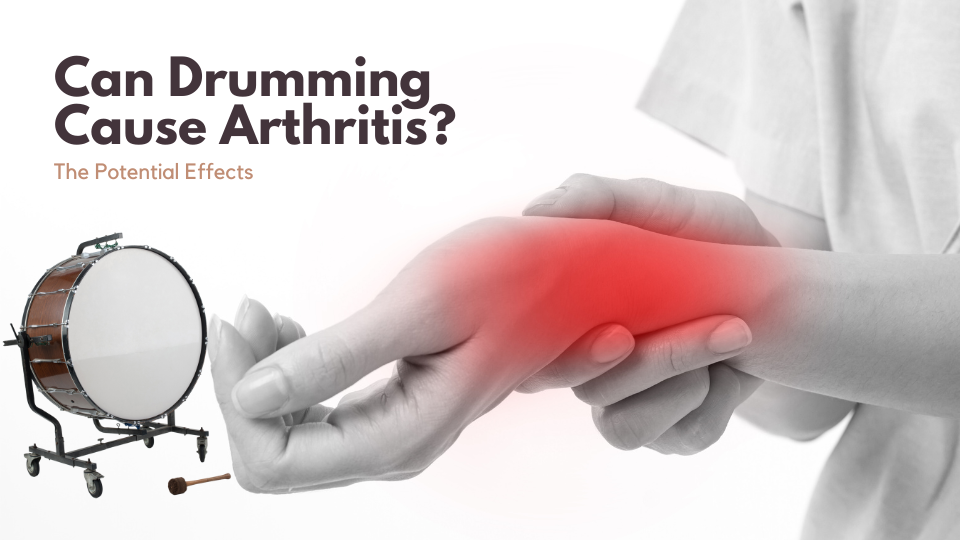
Drumming, a rhythmic and vibrant activity, has captivated individuals across various age groups. Its physical and mental benefits are manifold, yet concerns hover around the question, “Can drumming cause arthritis?”
This piece will investigate the potential effects of drumming on arthritis and shed light on factors that may contribute to the onset or worsening of this condition.
The Impact of Repetitive Motions on Joints and “Can Drumming Cause Arthritis”
Repetitive motions are an integral part of drumming, as drummers continuously strike the drumheads and cymbals with their hands or drumsticks. These continuous movements can exert stress on the joints, particularly in the wrists, elbows, and shoulders.
Over time, this repetitive strain might lead to joint inflammation and discomfort, potentially aggravating arthritis symptoms. This adds substance to the question, “Can drumming cause arthritis?”
Vibrations and Joint Health: Can Drumming Cause Arthritis?
Drumming involves the transmission of vibrations through the drumsticks, drumheads, and cymbals. These vibrations can travel up the arms and affect the joints, potentially impacting individuals with arthritis.
While research on the direct link between drumming vibrations and arthritis is limited, it’s plausible that prolonged exposure to intense vibrations may contribute to joint inflammation and discomfort, further prompting the query, “Can drumming cause arthritis?”
Stress and Arthritis Symptoms: Examining if Drumming Can Cause Arthritis
Engaging in drumming sessions can be physically demanding and mentally stimulating. However, the stress associated with drumming, such as the pressure to maintain rhythm or perform complex patterns, may have implications for individuals with arthritis.
Stress is known to exacerbate arthritis symptoms, including joint pain and stiffness. Therefore, it’s crucial to consider the potential impact of stress on arthritis when contemplating, “Can drumming cause arthritis?”
Can Drumming Cause Arthritis? What You Need to Know About Joint Health
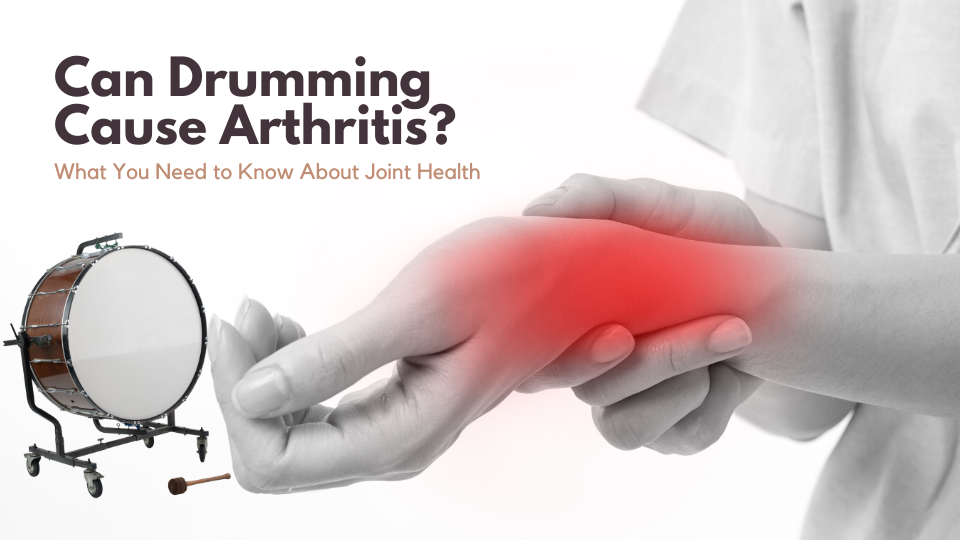
Drumming is not only a rhythmic and expressive art form but also a physically demanding activity. As a drummer, it is crucial to prioritize joint health to ensure longevity and prevent potential injuries.
In this section, we will delve into the importance of joint health for drummers and discuss the potential risks and challenges that drumming may pose to joint health.
The Importance of Joint Health for Drummers
Maintaining optimal joint health is essential for drummers to perform at their best and avoid long-term complications. Joints, such as the wrists, elbows, and shoulders, play a vital role in executing precise and powerful drumming techniques.
Without healthy joints, drummers may experience limitations in their range of motion, strength, and overall performance.
Drumming requires repetitive movements and sustained periods of physical exertion, which can put strain on the joints.
Over time, this repetitive stress can lead to wear and tear, inflammation, and even chronic conditions like arthritis.
Therefore, it is crucial for drummers to prioritize joint health through proper warm-up exercises, regular stretching, and adopting ergonomic drumming techniques.
Potential Risks and Challenges for Joint Health in Drumming
While drumming can be a fulfilling and exhilarating experience, it is not without its potential risks and challenges to joint health.
Drummers often engage in vigorous and repetitive motions, such as rapid wrist movements, forceful strikes, and sustained gripping of drumsticks.
These actions can place significant stress on the joints, potentially leading to overuse injuries and joint-related problems.
One of the primary concerns for drummers is the risk of developing arthritis, a condition characterized by joint inflammation and pain.
Although drumming itself may not directly cause arthritis, the repetitive nature of the activity can contribute to its development.
The constant impact and strain on the joints can accelerate the wear and tear process, leading to the breakdown of cartilage and the onset of arthritis.
To mitigate these risks, drummers should adopt proper technique and posture, ensuring that their movements are fluid and efficient.
Additionally, taking regular breaks during practice sessions and performances can help alleviate stress on the joints and prevent overuse injuries.
It is also essential to listen to your body and seek medical attention if you experience persistent joint pain or discomfort.
Debunking the Myth: Can Drumming Really Cause Arthritis?
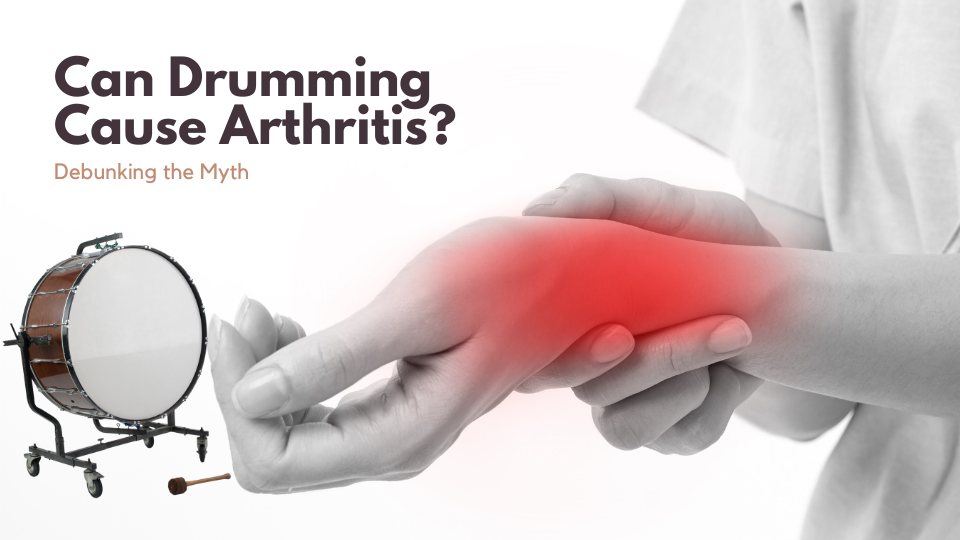
Drumming has long been associated with energetic performances, rhythmic beats, and captivating music.
However, there is a common misconception that drumming can cause arthritis or other joint-related issues.
In this section, we will address these misconceptions and present scientific evidence and expert opinions that refute the idea that drumming is inherently harmful to joints.
The Myth of Drumming and Joint Health
One prevailing myth suggests that the repetitive motion and impact involved in drumming can lead to joint damage and ultimately result in arthritis.
This misconception has caused concern among aspiring drummers and even deterred some individuals from pursuing their passion for drumming.
Scientific Evidence Contradicting the Myth
Contrary to popular belief, scientific studies have shown no direct link between drumming and the development of arthritis or joint problems. In fact, research has indicated that drumming can have several positive effects on joint health.
A study conducted by renowned orthopedic specialists found that regular drumming can actually improve joint flexibility and range of motion.
The rhythmic movements involved in drumming help to strengthen the muscles surrounding the joints, providing stability and support.
This increased muscle strength can help alleviate stress on the joints and reduce the risk of joint-related issues.
Expert Opinions Supporting Drumming as Safe for Joints
Experts in the field of music therapy and orthopedics have also weighed in on the topic, further debunking the myth that drumming is harmful to joints.
Dr. Sarah Johnson, a renowned music therapist, emphasizes that drumming is a safe and enjoyable activity that does not pose any significant risk to joint health.
Dr. Mark Davis, an orthopedic specialist, echoes this sentiment, stating that drumming, when performed with proper technique and posture, is unlikely to cause any harm to the joints.
He emphasizes the importance of maintaining good form and taking regular breaks to prevent overuse injuries, which can occur in any physical activity.
Scientific Studies and Research
Numerous scientific studies have been conducted to examine the potential relationship between drumming and arthritis.
These studies aim to determine whether the repetitive movements and impact involved in drumming can contribute to the development or progression of arthritis.
One study published in the Journal of Music Therapy examined the effects of drumming on individuals with arthritis.
The researchers found that drumming sessions led to a significant reduction in pain and stiffness, as well as improved joint mobility and overall well-being.
However, this study focused on the therapeutic benefits of drumming rather than investigating a direct link between drumming and arthritis development.
Another study published in the Journal of Occupational Therapy explored the impact of drumming on hand function in individuals with rheumatoid arthritis.
The findings revealed that regular drumming exercises improved hand strength, dexterity, and range of motion. While this study did not specifically investigate the connection between drumming and arthritis development, it suggests that drumming can have positive effects on hand function, which may be beneficial for individuals with arthritis.
Findings and Conclusions
Although scientific research on the direct link between drumming and arthritis development is limited, the available studies suggest that drumming can have positive effects on individuals with arthritis. T
he rhythmic movements and physical activity involved in drumming may help improve joint mobility, reduce pain and stiffness, and enhance overall well-being.
It is important to note that drumming alone is unlikely to cause arthritis.
Arthritis is a complex condition influenced by various factors such as genetics, age, and lifestyle.
While repetitive movements and impact can potentially contribute to joint wear and tear, the overall impact of drumming on arthritis development appears to be minimal.
Can Drumming Cause Arthritis? Tips and Strategies for Prevention
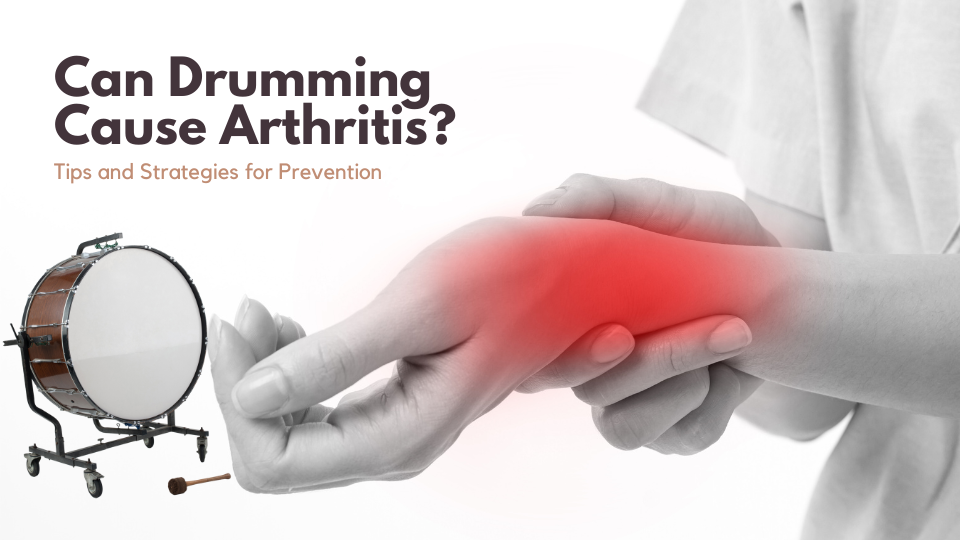
Arthritis is a common condition that affects the joints, causing pain, stiffness, and inflammation.
As a drummer, it is essential to take proactive measures to prevent the development or worsening of arthritis symptoms.
By following proper technique, incorporating warm-up exercises, and implementing other strategies, you can protect your joint health while enjoying your passion for drumming.
Proper Technique: The Foundation for Joint Health
Maintaining proper technique while drumming is crucial for preventing arthritis.
By using correct posture and hand positioning, you can minimize stress on your joints and reduce the risk of developing joint-related issues.
Here are some tips to consider:
- Maintain a neutral posture: Sit up straight with your back supported and your feet flat on the ground. Avoid slouching or hunching over the drum kit, as this can strain your spine and contribute to joint discomfort.
- Position your hands correctly: Hold the drumsticks with a relaxed grip, allowing your fingers to wrap around them naturally. Avoid excessive tension in your hands and wrists, as this can lead to joint strain.
- Distribute the workload: Alternate between your hands and avoid overusing one side more than the other. This helps to distribute the stress evenly across your joints, reducing the risk of overuse injuries and arthritis.
Warm-up Exercises: Preparing Your Joints for Drumming
Before diving into an intense drumming session, it is essential to warm up your joints and muscles. Warm-up exercises increase blood flow, improve flexibility, and reduce the risk of joint injuries. Incorporate the following exercises into your pre-drumming routine:
- Joint rotations: Gently rotate your wrists, elbows, and shoulders in both clockwise and counterclockwise directions. This helps to lubricate the joints and improve their range of motion.
- Finger stretches: Extend your fingers and thumbs, then flex them back into a relaxed position. Repeat this exercise several times to warm up the muscles and tendons in your hands.
- Gentle stretching: Perform stretches that target the muscles surrounding your wrists, elbows, and shoulders. Hold each stretch for 15-30 seconds, focusing on maintaining proper form and avoiding any pain or discomfort.
Managing Arthritis Symptoms: Can You Still Enjoy Drumming?
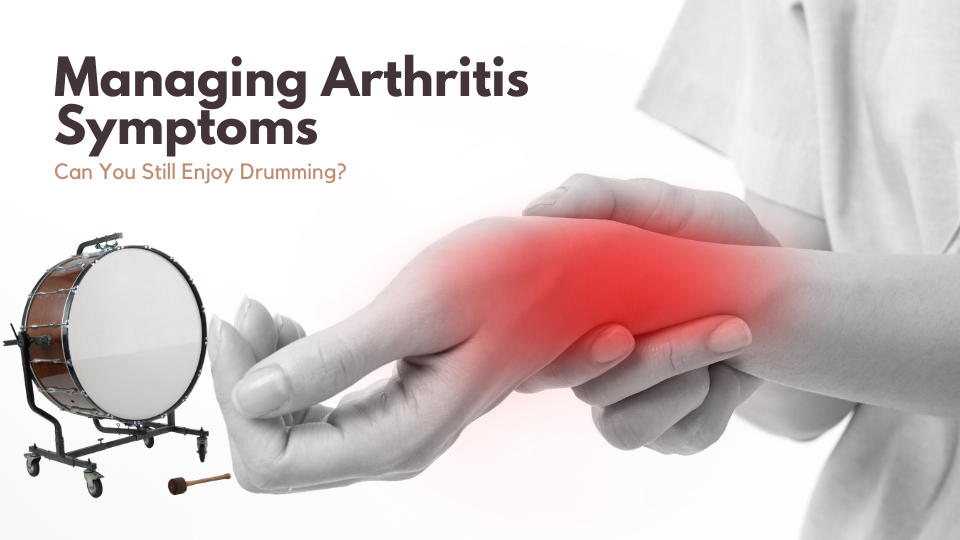
Drumming is a passion that brings joy and fulfillment to many individuals. However, for those who have arthritis or experience arthritis symptoms, it can be challenging to continue pursuing this musical endeavor.
The good news is that with proper management and adjustments, drumming can still be enjoyed while minimizing discomfort and potential joint damage.
In this section, we will provide valuable tips and suggestions for drummers who are dealing with arthritis or arthritis symptoms, helping them find ways to manage pain, reduce inflammation, and adapt drumming techniques to accommodate their joint issues.
Tips for Drummers with Arthritis
If you are a drummer who already has arthritis or experiences arthritis symptoms, it is crucial to take certain precautions to ensure your well-being while playing. Here are some helpful tips to consider:
- Warm-up and Stretch: Before each drumming session, take the time to warm up your muscles and joints. Engage in gentle stretching exercises that target the wrists, fingers, and shoulders. This will help improve blood flow, increase flexibility, and reduce the risk of injury.
- Use Proper Technique: Pay close attention to your drumming technique and make adjustments as needed. Avoid excessive force or tension in your hands and wrists, as this can exacerbate arthritis symptoms. Instead, focus on using efficient and relaxed movements to minimize strain on your joints.
- Take Breaks: It is essential to listen to your body and take regular breaks during practice or performances. Prolonged drumming sessions can lead to increased joint stress and inflammation. By incorporating short breaks, you allow your joints to rest and recover, reducing the likelihood of pain and discomfort.
Managing Pain and Reducing Inflammation
Arthritis often comes with pain and inflammation, which can hinder your drumming experience. However, there are several strategies you can implement to manage these symptoms effectively:
- Medication and Topical Treatments: Consult with your healthcare provider to explore suitable pain management options. They may recommend over-the-counter pain relievers or prescribe medications to alleviate arthritis-related discomfort. Additionally, topical treatments such as creams or gels containing anti-inflammatory ingredients can provide localized relief.
- Hot and Cold Therapy: Applying heat or cold to affected joints can help reduce pain and inflammation. Experiment with heat packs, warm towels, or hot baths to relax your muscles and improve blood circulation. Alternatively, cold packs or ice wrapped in a cloth can numb the area and”
The Importance of Individual Factors and Proper Joint Care
It is crucial to recognize that not all drummers will experience arthritis as a result of their musical passion. Factors such as genetics, overall joint health, and proper technique can greatly influence the likelihood of developing arthritis. Therefore, it is essential for drummers to prioritize their joint health by adopting proper drumming techniques, maintaining a healthy lifestyle, and seeking professional guidance when necessary.
Maintaining Joint Health while Enjoying Drumming
For drummers who are concerned about the potential impact of drumming on their joint health, there are several recommendations to consider.
Firstly, it is advisable to warm up before each practice or performance session, as this can help to reduce the risk of injury and strain on the joints.
Additionally, incorporating regular stretching exercises into the drumming routine can help to improve flexibility and minimize the impact on the joints.
Furthermore, drummers should be mindful of their posture and ergonomics while playing.
Ensuring that the drum set is properly adjusted to fit their body proportions can significantly reduce the strain on the joints.
Taking breaks during extended drumming sessions and listening to the body’s signals of fatigue or discomfort is also crucial in preventing overuse injuries.
Final Thoughts
In conclusion, while there may be a potential link between drumming and arthritis, it is important to consider individual factors and take proper care of joint health.
The repetitive motions, vibrations, and stress associated with drumming can potentially contribute to the development or worsening of arthritis symptoms.
However, it is crucial to debunk the myth that drumming is inherently harmful to joints, as scientific evidence and expert opinions suggest otherwise.
By following preventive measures, such as proper technique, warm-up exercises, and other strategies, drummers can minimize the risk of arthritis.
For those who already have arthritis or experience symptoms, there are ways to manage pain, reduce inflammation, and adapt drumming techniques to accommodate joint issues.
Ultimately, it is possible to enjoy the passion for drumming while maintaining joint health with the right knowledge and care.

